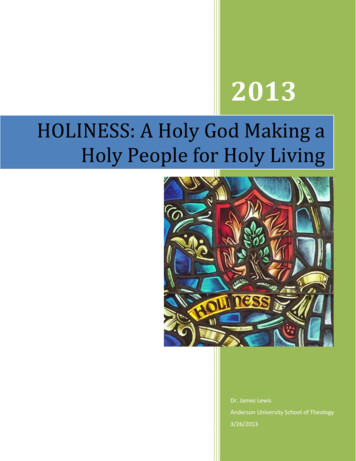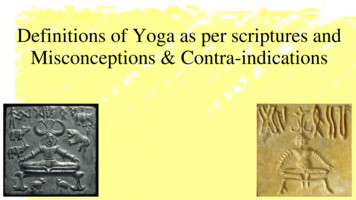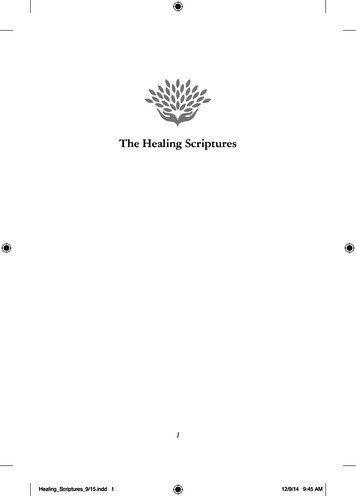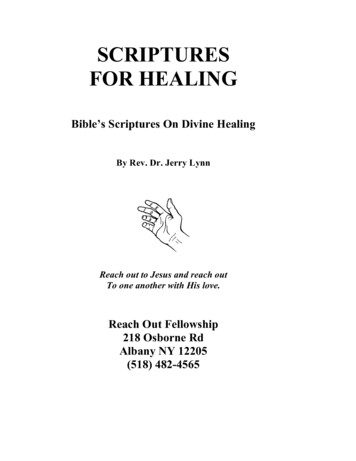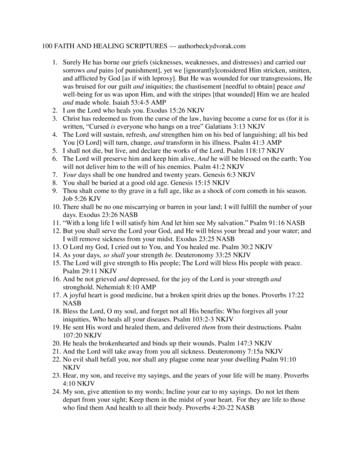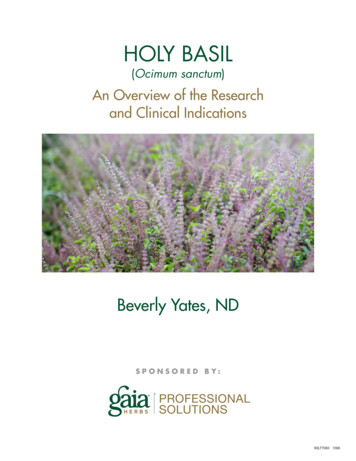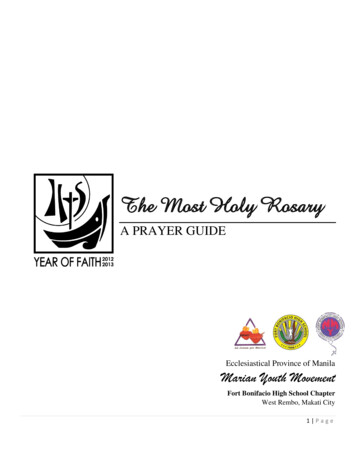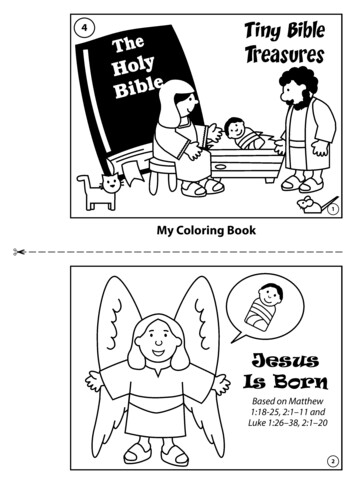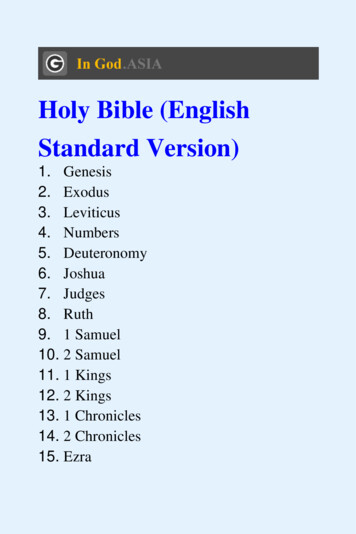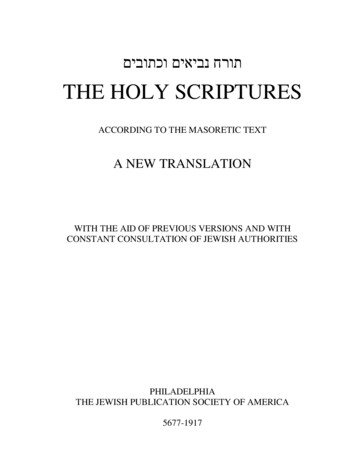
Transcription
תורח נביאים וכתובים THE HOLY SCRIPTURESACCORDING TO THE MASORETIC TEXTA NEW TRANSLATIONWITH THE AID OF PREVIOUS VERSIONS AND WITHCONSTANT CONSULTATION OF JEWISH AUTHORITIESPHILADELPHIATHE JEWISH PUBLICATION SOCIETY OF AMERICA5677-1917
Copyright 1917,By The Jewish Publication Society of AmericaAll rights reservedThe Lakeside Press, Chicagoii
PREFACEThe following is from the preface to the Jewish Publication Society's 1917edition of the Hebrew Bible in English:The sacred task of translating the Word of God, as revealed to Israel throughlawgiver, prophet, psalmist, and sage, began at an early date. According to anancient rabbinic interpretation, Joshua had the Torah engraved upon the stones ofthe altar (Joshua 8:32) not in the original Hebrew alone, but in all the languagesof mankind, which were held to be seventy, in order that all men might becomeacquainted with the words of the Scriptures. This statement, with itsuniversalistic tendency, is, of course, a reflex of later times, when the HebrewScriptures had become a subject of curiosity and perhaps also of anxiety to thepagan or semi-pagan world.While this tradition contains an element of truth, it is certain that the primaryobject of translating the Bible was to minister to a need nearer home. Upon theestablishment of the Second Commonwealth under Ezra and Nehemiah, itbecame imperative to make the Torah of God 'distinct and giving sense' throughthe means of interpretation (Nehemiah 8:8 and 13:24), that the Word of Godmight be understood by all the people. The Rabbis perceived in this activity ofthe first generation of the Sopherim the origin of the Aramaic translation knownas the Targum, first made orally and afterwards committed to writing, which wasnecessitated by the fact that Israel had forgotten the sacred language, and spokethe idiom current in a large part of western Asia. All this, however, is veiled inobscurity, as is the whole inner history of the Jews during the Persian rule.The historic necessity for translation was repeated with all the great changes inIsrael's career. It is enough to point to the Septuagint, or the Greek translation ofthe Scriptures, the product of Israel's contact with the Hellenistic civilizationdominating the world at that time; to the Arabic translation by the Gaon Saadya,when the great majority of the Jewish people came under the sceptre ofMohammedan rulers; and to the German translation by Mendelssohn and hisschool, at the dawn of a new epoch, which brought the Jews in Europe, most ofwhom spoke a German dialect, into closer contact with their neighbours. Thesetranslations are all historical products intimately connected with Israel'swanderings among the nations and with the great events of mankind in general.Ancient and continuous as this task of translation was, it would be a mistake tothink that there were no misgivings about it. At least it is certain that opinionsiii
were divided as to the desirability of such undertakings. While Philo and hisAlexandrian coreligionists looked upon the translation of the Seventy as a workof inspired men, the Palestinian Rabbis subsequently considered the day onwhich the Septuagint was completed as one of the most unfortunate in Israel'shistory, seeing that the Torah could never be adequately translated. And there areindications enough that the consequences of such translations were not all of adesirable nature. However, in view of the eagerness with which they wereundertaken almost in every land and in every great epoch of the world's history, itis evident that the people at large approved of such translations, thinking them tobe a heave-offering to the Lord of each newly acquired vernacular adopted in thecourse of the ever-changing conditions of history, and in particular a tribute tothe beauty of Japheth dwelling in the spiritual tents of Israel.The greatest change in the life of Israel during the last two generations was hisrenewed acquaintance with English-speaking civilization. Out of a handful ofimmigrants from Central Europe and the East who saw the shores of the NewWorld, or even of England and her colonies, we have grown under Providenceboth in numbers and in importance, so that we constitute now the greatest sectionof Israel living in a single country outside of Russia. We are only following in thefootsteps of our great predecessors when, with the growth of our numbers, wehave applied ourselves to the sacred task of preparing a new translation of theBible into the English language, which, unless all signs fail, is to become thecurrent speech of the majority of the children of Israel.The need of such a translation was felt long ago. Mention may here be made ofthe work of Isaac Leeser in America, which was both preceded and followed bytwo translations produced in England: the one by Dr. A. Benisch, the other by Dr.Michael Friedlander. The most popular, however, among these translations wasthat of Lesser, which was not only the accepted version in all the synagogues ofthe United States, but was also reproduced in England. Its great merit consistedin the fact that it incorporated all the improvements proposed by theMendelssohn School and their successors, whose combined efforts were includedand further developed in the so-called Zunz Bible, which enjoyed a certainauthority among German Jews for several generations. With the advance of timeand the progress made in almost all departments of Bible study, it was found thatLeeser's translation would bear improvement and recasting.Steps leading to the preparation of a new translation into the English languagewere taken by the Jewish Publication Society of America in 1892. It wasintended to secure, if possible, through the co-operation of scholars in the UnitedStates and in Great Britain, a new translation of each book, and to place it in theiv
hands of an Editorial Committee, who by correspondence with the translatorsshould harmonize the results of the work of the individual contributors. Thismethod was followed until 1901 under the general direction of Doctor MarcusJastrow, Editor-in-Chief, with Doctor Kaufman Kohler and Doctor Frederick deSola Mendes as the other members of the Editorial Committee.**There is given herewith a list of the translations prepared for the Society:Genesis, Max Landsberg, Rochester, N. Y.Exodus and Leviticus, L. N. Dembitz (deceased), Louisville, Ky.Numbers, David Philipson, Cincinnati, Ohio.Deuteronomy, F. de Sola Mendes, New York.Joshua, Joseph H. Hertz, London, England.Judges, Stephen S. Wise, New York.II Samuel, Bernard Drachman, New York.Jeremiah, Sabato Morais (deceased), Philadelphia, Pa.Ezekiel, Henry W. Schneeberger, Baltimore, Md.Joel, Oscar Cohen (deceased), Mobile, Ala.Amos, H. Pereira Mendes, Now York.Obadiah and Jonah, J. Voorsanger (deceased), San Francisco, California.Micah, Maurice H. Harris, New York.Nahum, L. Mayer (deceased), Pittsburgh, Pa.Zephaniah, M. Schlesinger, Albany, N. Y.Haggai, S. Mendelsohn, Wilmington, N. C.Malachi, D. Davidson, New York.Job, Marcus Jastrow (deceased), Philadelphia, Pa.Ruth, Joseph Krauskopf, Philadelphia, Pa.Ecclesiastes, Gustav Gottheil (deceased), New York.Esther, William Rosenau, Baltimore, Md.I and II Chronicles, M. Mielziner (deceased), Cincinnati, Ohio.)It became apparent in 1901 that by this procedure the publication of atranslation of the entire Hebrew Bible would be indefinitely delayed, andaccordingly the Book of Psalms, translated by Doctor Kohler and revised by hiscolleagues, was given to the press and issued in 1903. The death of DoctorJastrow in that year required the formation of a new committee under thechairmanship of Doctor Solomon Schechter. This committee, however, soonfound that the method adopted was too complex, and that it was impossible toaccomplish by correspondence the extensive work required.In 1908 the Jewish Publication Society of America and the Central Conferenceof American Rabbis reached an agreement to cooperate in bringing out the newv
translation upon a revised plan of having the entire work done by a Board ofEditors instead of endeavoring to harmonize the translations of individualcontributors. As a result of this understanding the present Board, composed ofDoctor Solomon Schechter, Doctor Cyrus Adler, and Doctor Joseph Jacobs,representing the Jewish Publication Society of America, and Doctor KaufmanKohler, Doctor David Philipson, and Doctor Samuel Schulman, representing theCentral Conference of American Rabbis, was constituted, and by mutualagreement Professor Max L. Margolis was chosen as the seventh member, he tobe the Editor-in-Chief of the work and Secretary to the Editorial Board, of whichDoctor Cyrus Adler was elected Chairman. Incidentally the selection thus maderesulted in an equal representation of the Jewish Theological Seminary ofAmerica at New York, of the Hebrew Union College at Cincinnati, and of theDropsie College for Hebrew and Cognate Learning at Philadelphia. For one yearProfessor Israel Friedlaender acted as a member of the Board in the stead ofDoctor Schechter.The method employed by the Board was as follows:In preparing the manuscript for consideration by the Board of Editors,Professor Margolis took into account the existing English versions, the standardcommentaries, ancient and modern, the translations already made for the JewishPublication Society of America, the divergent renderings from the RevisedVersion prepared for the Jews of England, the marginal notes of the RevisedVersion, and the changes of the American Committee of Revisers. Due weightwas given to the ancient versions as establishing a tradition of interpretation,notably the Septuagint and the versions of Aquila, Symmachus, and Theodotion,the Targums, the Peshitta, the Vulgate, and the Arabic version of Saadya.Talmudic and midrashic allusions and all available Jewish commentators, boththe great medieval authorities, like Rashi, Kimhi, and Ibn Ezra, and the modernsS. D. Luzzatto, Malbim, and Ehrlich, as well as all the important non-Jewishcommentators, were consulted. On this basis, a manuscript was prepared by theEditor-in-Chief and a copy sent to every member of the Board of Editors. Sixteenmeetings, covering a period of seven years and occupying one hundred and sixtyworking days, were held, at which the proposals in this manuscript and manyadditional suggestions by the members of the Board were considered. Each pointwas thoroughly discussed, and the view of the majority was incorporated into themanuscript. When the Board was evenly divided, the Chairman cast the decidingvote. From time to time subcommittees were at work upon points left open, andtheir reports, submitted to the Board, were discussed and voted upon. The proofof the entire work was sent to each member of the Board for revision, and thenew proposals which were made by one or another were in turn submitted to avi
vote by correspondence and to a final vote at the last meeting of the Board, heldin October-November, 1915.The present translation is the first for which a group of men representative ofJewish learning among English-speaking Jews assume joint responsibility, allprevious efforts in the English language having been the work of individualtranslators. It has a character of its own. It aims to combine the spirit of Jewishtradition with the results of biblical scholarship, ancient, medieval, and modern.It gives to the Jewish world a translation of the Scriptures done by men imbuedwith the Jewish consciousness, while the non-Jewish world, it is hoped, willwelcome a translation that presents many passages from the Jewish traditionalpoint of view.The repeated efforts by Jews in the field of biblical translation show theirsentiment toward translations prepared by other denominations. The dominantfeature of this sentiment, apart from the thought that the christologicalinterpretations in non-Jewish translations are out of place in a Jewish Bible, isand was that the Jew cannot afford to have his Bible translation prepared for himby others. He cannot have it as a gift, even as he cannot borrow his soul fromothers. If a new country and a new language metamorphose him into a new man,the duty of this new man is to prepare a new garb and a new method ofexpression for what is most sacred and most dear to him.We are, it is hardly needful to say, deeply grateful for the works of our nonJewish predecessors, such as the Authorised Version with its admirable diction,which can never be surpassed, as well as for the Revised Version with its amplelearning--but they are not ours. The Editors have not only used these famousEnglish versions, but they have gone back to the earlier translations of Wycliffe,Tyndale, Coverdale, the Bishops' Bible, and the Douai Version, which is theauthorised English translation of the Vulgate used by the Roman Catholics; in aword, upon doubtful points in style, all English versions have been drawn upon.The renditions of parts of the Hebrew Scriptures by Lowth and others in theeighteenth century and by Cheyne and Driver in our own days were likewiseconsulted.As to the text and order of the biblical books, the present translation followsJewish tradition, the Sacred Scriptures having come down in a definite compassand in a definite text. They are separated into three divisions: Law (Torah,Pentateuch), Prophets (Nebi'im), Writings (Ketubim). Each of these possesses adifferent degree of holiness or authority. In the Prophets and the Writings theorder of the books varies in manuscripts or among Jewish authorities; but there isabsolute agreement as to the compass of these two divisions, and no book isvii
transposed from the one into the other. Thus Ruth, Lamentations, and Daniel areall placed in the division of Writings--not among the Prophets, as in non-Jewishversions.With every step by which each of the three parts was sealed, nothing to beadded or to be taken away, the text was likewise fixed and thenceforth made theobject of zealous watchfulness. Even wit
the altar (Joshua 8:32) not in the original Hebrew alone, but in all the languages of mankind, which were held to be seventy, in order that all men might become acquainted with the words of the Scriptures. This statement, with its universalistic tendency, is, of course, a reflex of later times, when the Hebrew Scriptures had become a subject of curiosity and perhaps also of anxiety to the .
